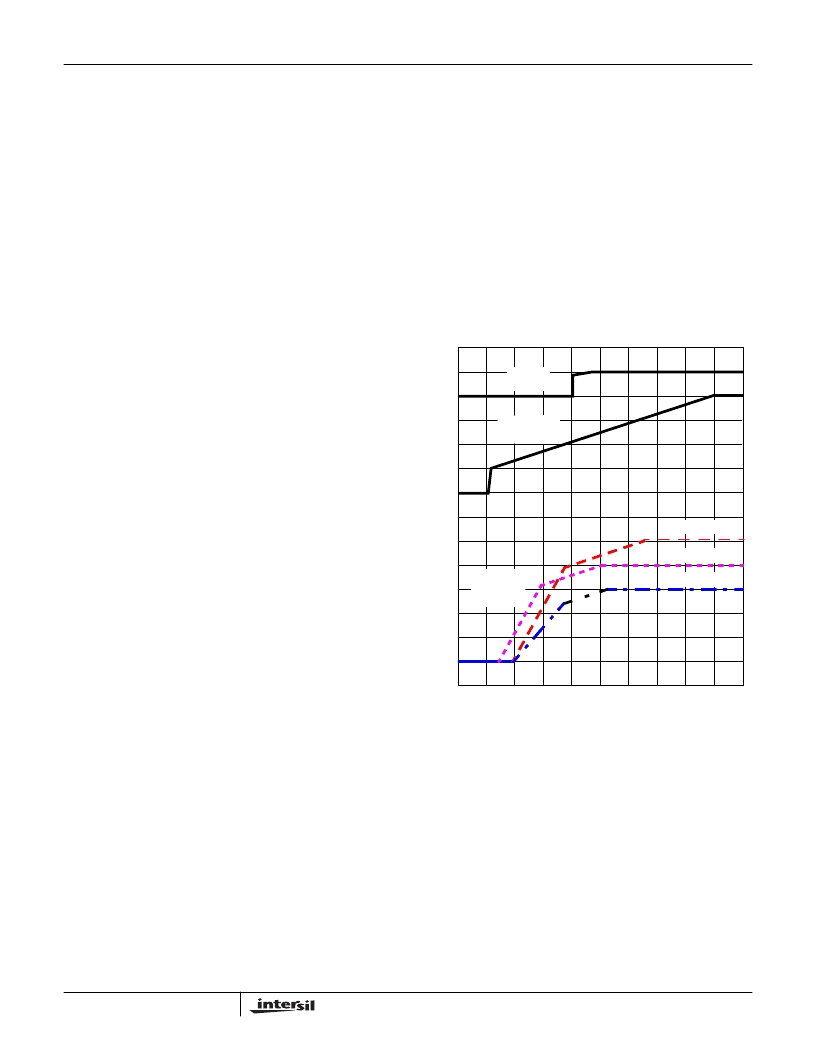- 您现在的位置:买卖IC网 > PDF目录371821 > HIP6018CB (HARRIS SEMICONDUCTOR) Advanced PWM and Dual Linear Power Control PDF资料下载
参数资料
| 型号: | HIP6018CB |
| 厂商: | HARRIS SEMICONDUCTOR |
| 元件分类: | 稳压器 |
| 英文描述: | Advanced PWM and Dual Linear Power Control |
| 中文描述: | SWITCHING CONTROLLER, 1000 kHz SWITCHING FREQ-MAX, PDSO24 |
| 封装: | SOIC-24 |
| 文件页数: | 7/14页 |
| 文件大小: | 133K |
| 代理商: | HIP6018CB |

2-230
VIN2 (Pin 12)
This pin supplies power to the internal regulator. Connect
this pin to a suitable 3.3V source.
Additionally, this pin is used to monitor the 3.3V supply. If,
following a startup cycle, the voltage drops below 2.05V
(typically), the chip shuts down. A new soft-start cycle is
initiated upon return of the 3.3V supply above the under-
voltage threshold.
Description
Operation
The HIP6018 monitors and precisely controls 4 output
voltage levels (Refer to Figures 1, 2, and 3). It is designed for
microprocessor computer applications with 3.3V and 5V
power, and 12V bias input from an ATX power supply. The IC
has one PWM controller, a linear controller, and a linear
regulator. The PWM controller is designed to regulate the
microprocessor core voltage (V
OUT1
) by driving 2 MOSFETs
(Q1 and Q2) in a synchronous-rectified buck converter
configuration. The core voltage is regulated to a level
programmed by the 5-bit digital-to-analog converter (DAC).
An integrated linear regulator supplies the 2.5V clock power
(V
OUT2
). The linear controller drives an external MOSFET
(Q3) to supply the GTL bus power (V
OUT3
).
Initialization
The HIP6018 automatically initializes upon receipt of input
power. Special sequencing of the input supplies is not
necessary. The Power-On Reset (POR) function continually
monitors the input supply voltages. The POR monitors the
bias voltage (+12V
IN
) at the VCC pin, the 5V input voltage
(+5V
IN
) on the OCSET1 pin, and the 3.3V input on the VIN2
pin. The normal level on OCSET1 is equal to +5V
IN
less a
fixed voltage drop (see over-current protection). The POR
function initiates soft-start operation after all three input supply
voltages exceed their POR thresholds.
Soft-Start
The POR function initiates the soft-start sequence. Initially,
the voltage on the SS pin rapidly increases to approximately
1V (this minimizes the soft-start interval). Then an internal
11
μ
A current source charges an external capacitor (C
SS
) on
the SS pin to 4V. The PWM error amplifier reference input (+
terminal) and output (COMP1 pin) is clamped to a level
proportional to the SS pin voltage. As the SS pin voltage
slews from 1V to 4V, the output clamp generates PHASE
pulses of increasing width that charge the output
capacitor(s). After this initial stage, the reference input clamp
slows the output voltage rate-of-rise and provides a smooth
transition to the final set voltage. Additionally both linear
regulator’s reference inputs are clamped to a voltage
proportional to the SS pin voltage. This method provides a
rapid and controlled output voltage rise.
Figure 3 shows the soft-start sequence for the typical
application. At T0 the SS voltage rapidly increases to
approximately 1V. At T1, the SS pin and error amplifier
output voltage reach the valley of the oscillator’s triangle
wave. The oscillator’s triangular waveform is compared to
the clamped error amplifier output voltage. As the SS pin
voltage increases, the pulse-width on the PHASE pin
increases. The interval of increasing pulse-width continues
until each output reaches sufficient voltage to transfer
control to the input reference clamp. If we consider the 2.0V
output (V
OUT1
) in Figure 3, this time occurs at T2. During
the interval between T2 and T3, the error amplifier
reference ramps to the final value and the converter
regulates the output to a voltage proportional to the SS pin
voltage. At T3 the input clamp voltage exceeds the
reference voltage and the output voltage is in regulation.
The remaining outputs are also programmed to follow the SS
pin voltage. Each linear output (V
OUT2
and V
OUT3
) initially
follows a ramp similar to that of the PWM output. When each
output reaches sufficient voltage the input reference clamp
slows the rate of output voltage rise. The PGOOD signal
toggles ‘high’ when all output voltage levels have exceeded
their under-voltage levels. See the Soft-Start Interval section
under Applications Guidelines for a procedure to determine
the soft-start interval.
Fault Protection
All three outputs are monitored and protected against
extreme overload. A sustained overload on any linear
FIGURE 6. SOFT-START INTERVAL
0V
0V
0V
TIME
PGOOD
(2V/DIV)
SOFT-START
(1V/DIV)
OUTPUT
VOLTAGES
(0.5V/DIV)
V
OUT1
(DAC = 2V)
V
OUT2
( = 2.5V)
V
OUT3
( = 1.5V)
T1
T2
T3
T0
T4
HIP6018
相关PDF资料 |
PDF描述 |
|---|---|
| HIP6019BCB | Advanced Dual PWM and Dual Linear Power Control |
| HIP6019B | FPGA - 100000 SYSTEM GATE 2.5 VOLT - NOT RECOMMENDED for NEW DESIGN |
| HIP6028EVAL1 | Advanced PWM and Dual Linear Power Control with Integrated ACPI Support Interface |
| HIP6028 | Advanced PWM and Dual Linear Power Control with Integrated ACPI Support Interface |
| HIP6028CB | Advanced PWM and Dual Linear Power Control with Integrated ACPI Support Interface |
相关代理商/技术参数 |
参数描述 |
|---|---|
| HIP6018CB-T | 制造商:Rochester Electronics LLC 功能描述:- Tape and Reel |
| HIP6018EVAL1 | 制造商:INTERSIL 制造商全称:Intersil Corporation 功能描述:Advanced PWM and Dual Linear Power Control |
| HIP6019 | 制造商:IRF 制造商全称:International Rectifier 功能描述:5-BIT PROGRAMMABLE SYNCHRONOUS BUCK, NON-SYNCHRONOUS,ADJUSTABLE LDO AND 200mA ON-BOARD LDO |
| HIP6019B | 制造商:INTERSIL 制造商全称:Intersil Corporation 功能描述:Advanced Dual PWM and Dual Linear Power Control |
| HIP6019B_05 | 制造商:INTERSIL 制造商全称:Intersil Corporation 功能描述:Advanced Dual PWM and Dual Linear Power Control |
发布紧急采购,3分钟左右您将得到回复。